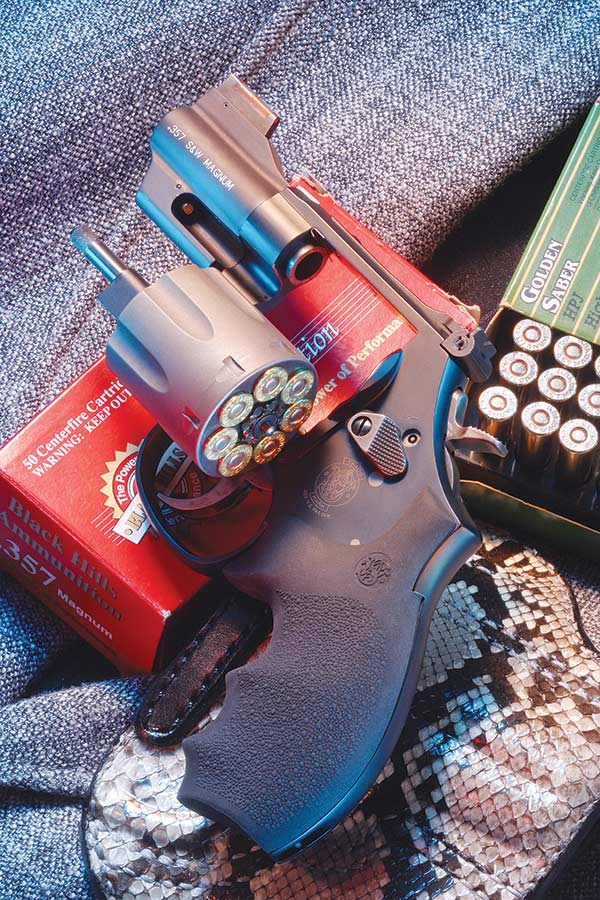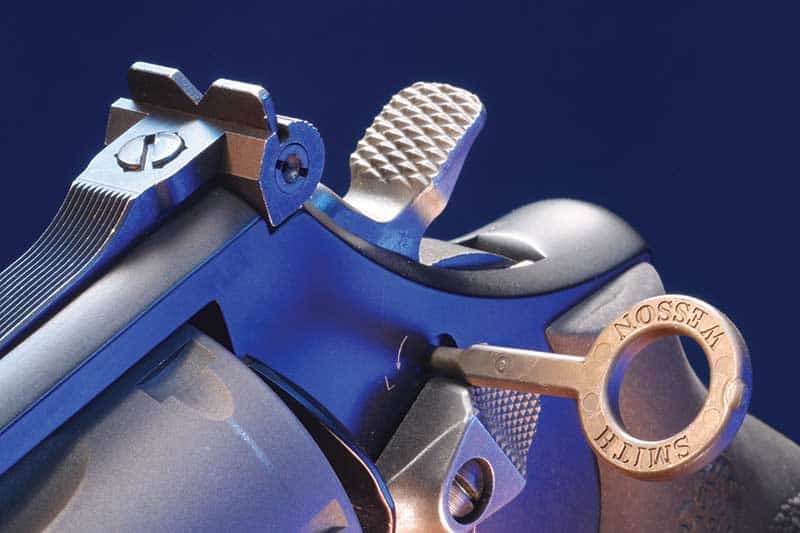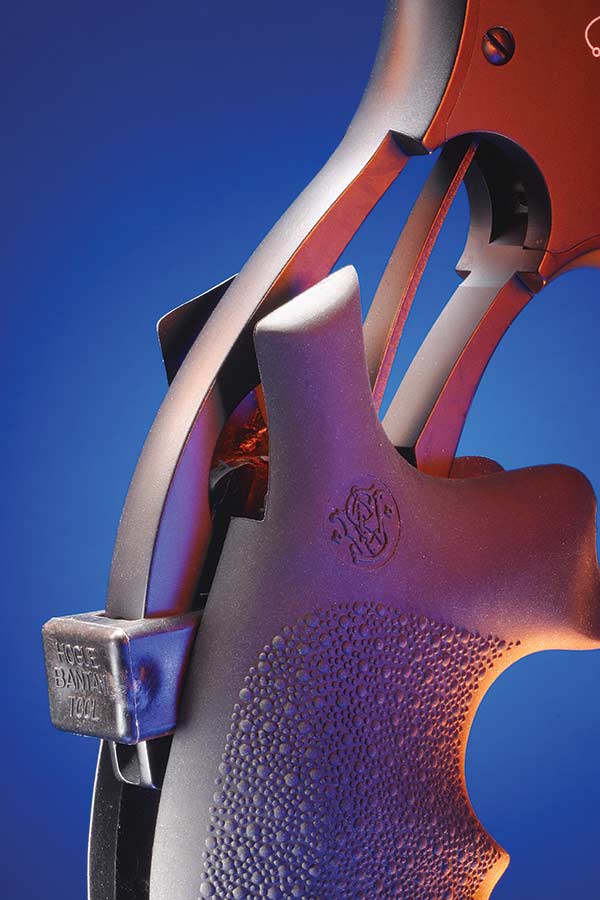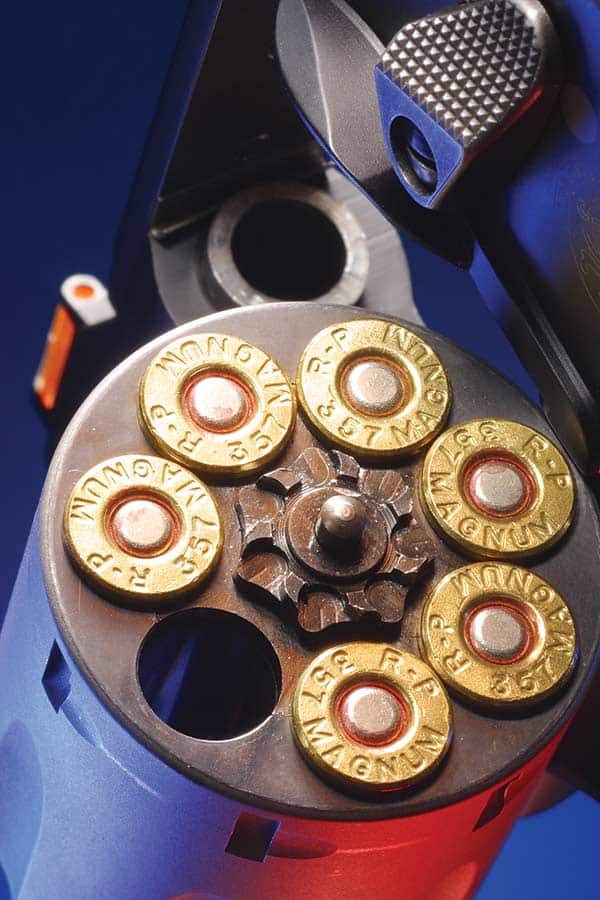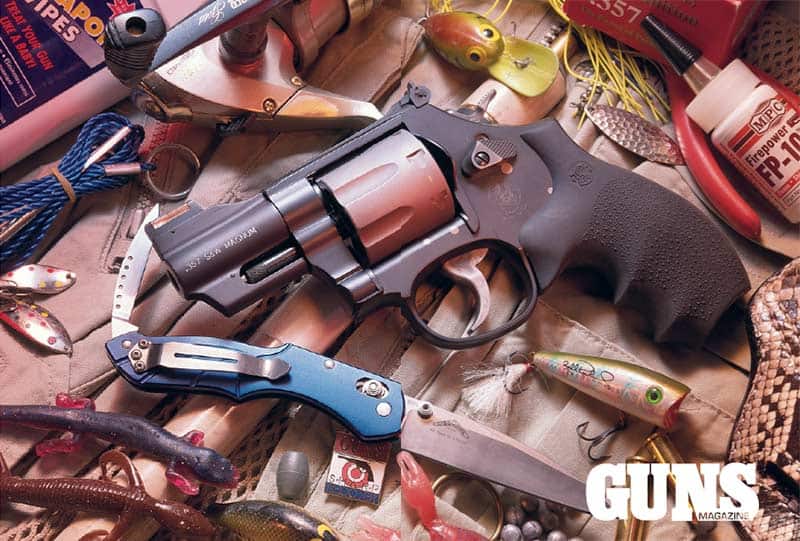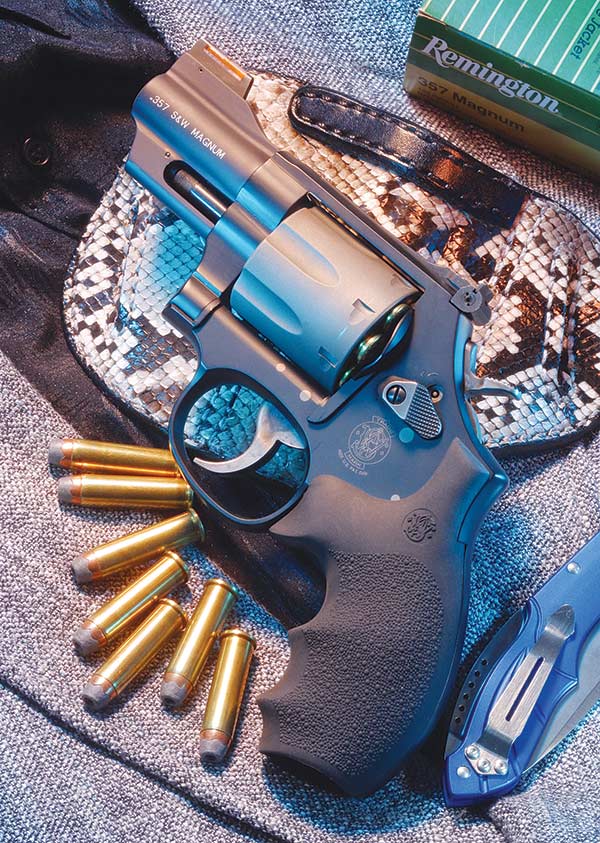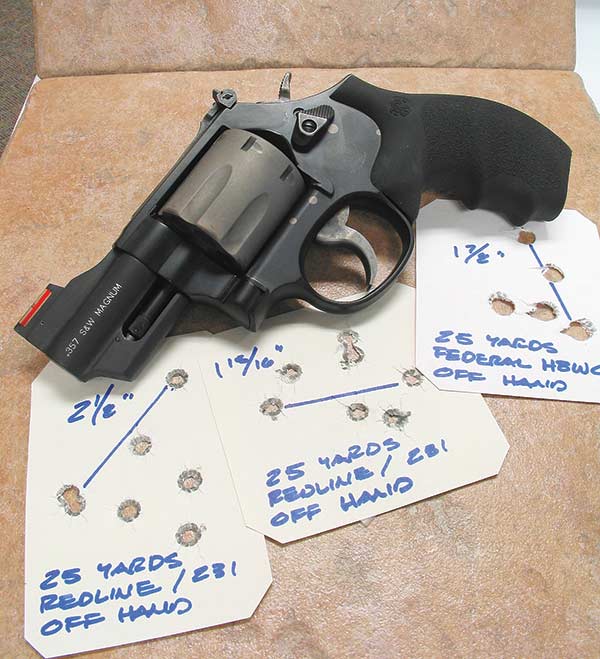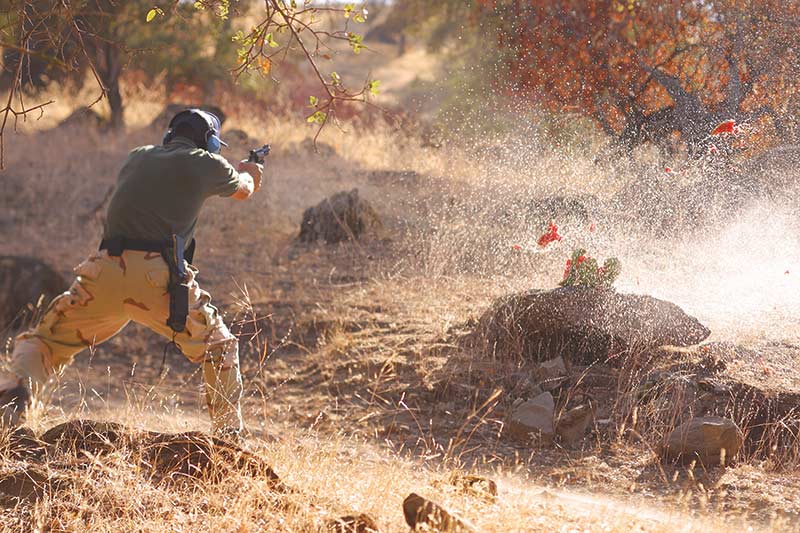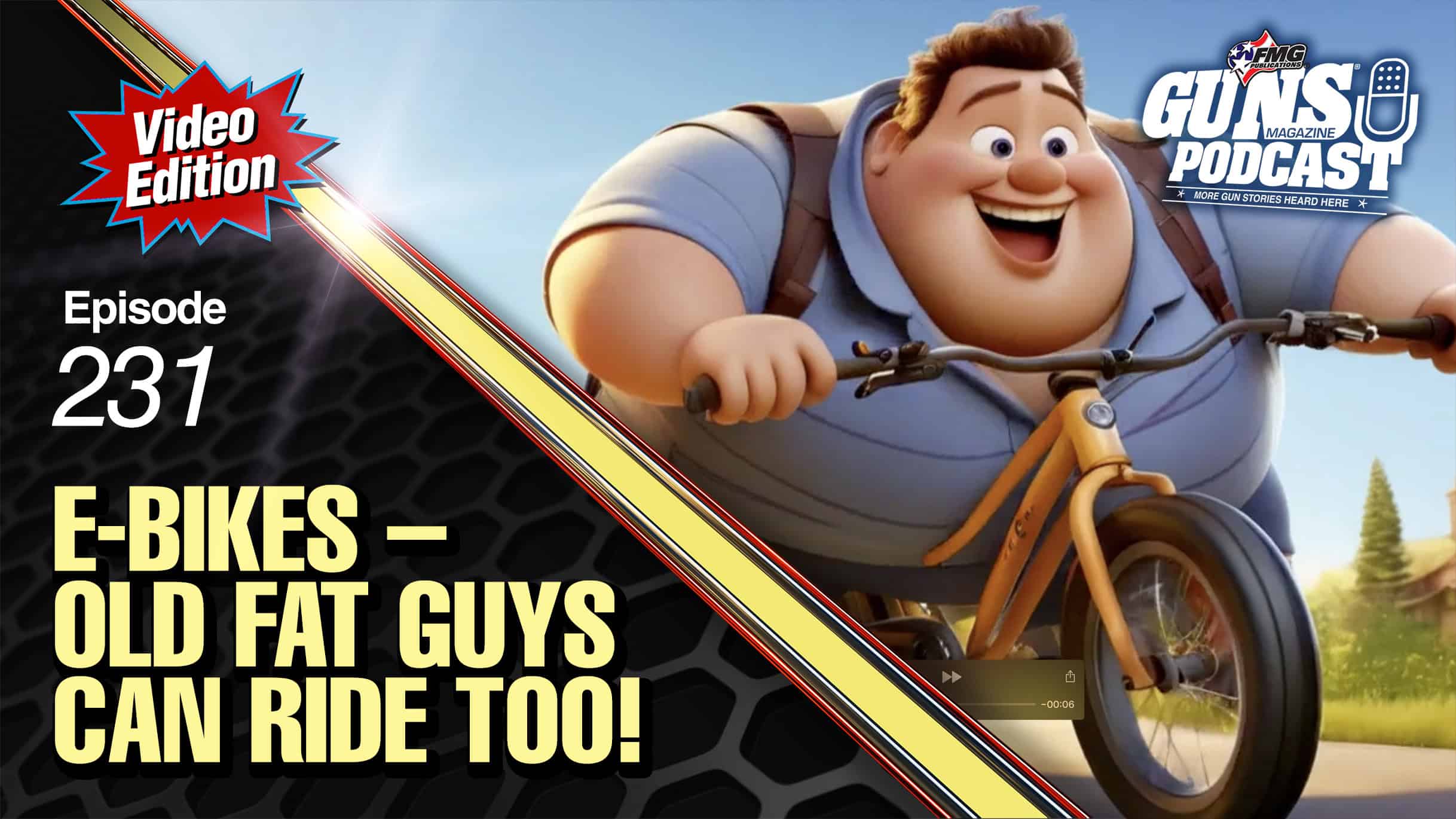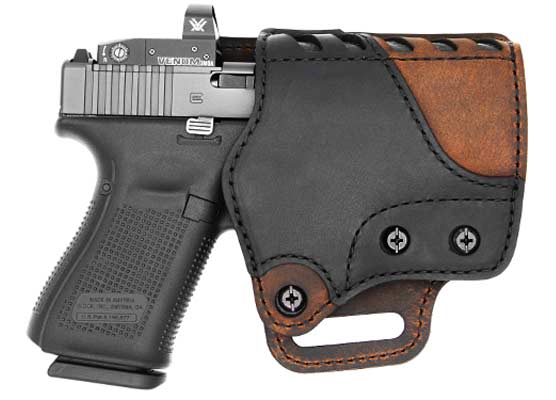Minimum Magnum
If It Were Any Lighter... You'd Have to Tie It Down
Fall mornings in the desert can be pretty crisp. I left the house early, enjoying the long drive in the darkness, but now, with only a faint glimmer along the horizon, I’m ready for the sunrise. A tiny fire of dead greasewood branches warms my hands and per-fumes the air with pungent woodsmoke. The barely noticeable tug on my hip comes from the flyweight S&W I’ve driven here to shoot.
A fit of nostalgia sends me rummaging through the truck, where I find the scuffed holster that carries my first .357 revolver. I haul it back to the fire to look at and enjoy the feel of this old piece of iron.
A S&W Model 28 “Highway Patrolman,” the feel of it brings back countless memories. Thoughts of many other campfires with this old Smith at my side, and memories of a teenage kid pumping 32 cent gas to make the $120 purchase price.
Unholstering the new S&W 386PD, the contrast is amazing. The beefy, N-framed Model 28 weighs a hefty 42 ounces. At only 17.5 ounces, the 386 is less than half as heavy.
The 386PD is a seven-shot, .357 Magnum revolver built on S&W’s L-frame. The finish is subdued and non-reflective, a pleasing mix of muted tones. The rubber stocks are from Houge, and feature an exposed back-strap and very slight finger extension at the bottom of the frame.
The trigger is smooth faced, about 5/16-inch in width. It’s well suited to both deliberate single-action shooting and fast double-action work. At 3/8-inches in width, the hammer spur is easier to cock than the old narrow “service” hammer, but it’s not unduly large for concealed carry. Like all current S&Ws, the old familiar “hammer nose” is gone, replaced by a frame-mounted firing pin. The 386PD also incorporates S&W’s integral key locking device.
Tool For Parents
While many will have no use for this feature, it’s hard to turn your nose up at it. It is completely unobtrusive and can’t be accidentally activated. If however, your house-hold includes children too young to be taught the ironclad rules of safe gun handling, the locking system provides one more barrier the wise parent can use to prevent a tragedy. For this reason, it’s a good addition.
The S&W 386PD is available with conventional red ramp Patridge sights, or with a HIVIS sighting system. The test revolver features the latter.
The front sight has a rounded “bead” profile, and carries a bright orange fiber-optic insert. A roughly half-inch window cut out of the front sight admits light to be gathered by the insert. This window is filled with clear epoxy. The adjustable rear sight’s blade is cut with a shallow “V” notch to mate with the bead front sight.
Out of the box, the trigger breaks at 3.5 pounds in single action. It’s crisp and clean, just as we normally see with S&Ws. The double-action trigger pull is heavy. It’s heavier than either my static trigger weight set or my spring scale will measure.
There’s no excuse for this. Yes, a new revolver must be 100-percent reliable, but S&W knows how to deliver them both reliable and at a reasonable weight of pull. They should challenge themselves to do so.
Instead of fussing around trying to measure the DA pull weight, I popped open the sideplate, trimmed one coil from the rebound spring, and substituted the ground and polished mainspring and strain screw from my old Model 19. The result was a very nice double action pull.
Space Age Revolver
While externally the 386PD looks quite similar to S&W swing-out cylinder revolvers manufactured since 1896, it’s truly a space-age product in terms of materials and construction techniques.
The frame, barrel shroud and cylinder yoke are con-structed of S&W’s Scandium alloy. The introduction of small quantities of Scandium into aluminum alloys pro-duces finer grain structure and yields a significant increase in strength. S&W commenced use of this exotic alloy in late 1999.
The cylinder of the 386PD is fabricated of titanium, while the barrel liner is constructed of stainless steel for maximum wear and corrosion resistance.
Construction techniques used to produce today’s S&Ws are no less novel than the mate-rials. Computer Numeric Controlled machining permits the production of extremely uniform, accurately dimensioned components and mini-mizes waste of exotic materials. Much of the internal lockwork has been redesigned to make use of the Metal Injection Molding process. The result is highly uniform and durable ham-mers, triggers, rebound slides, etc., and a sig-nificant cost savings.
Affordable Quality
That last statement may bristle some con-sumers. New S&W revolvers are hardly cheap. Nor should they be. They’re beauti-fully made, accurate, and a product that if used with the least bit of care may easily be passed down to your next generation. But the retail price and features of current S&Ws are the product of an equation that has labor and production costs as its bottom line.
To be frank, I much prefer older S&W revolvers. Features such as five-screw frames, pinned barrels, internal components artfully machined from forgings, the old S&W long action and brilliant bright-blued finish are enough to raise my pulse danger-ously. S&W could easily build revolvers with these characteristics today. However, few could afford them. How many $2,000 Triple-Locks, or 1955 Target Models do you think would be sold? Not many.
In the old pre-war and early post-war economy, skilled handwork was one of the least expensive aspects of production costs. Today, it’s one of the highest. S&W faced a choice. Raise retail prices exorbitantly, or find new ways of producing an equivalent quality product at less cost.
Good Guns Made Tougher
The above is true, but it’s only one side of the coin. Many of the changes made to S&W revolvers in recent years were not for cost management, but rather were designed to produce a better, more durable product.
Take that frame-mounted firing pin for example. I’ve replaced a number of the old hammer-mounted firing pins over the years, but I’ve yet to see the new design fail. Timing and cylinder lockup on the newer guns also seems significantly more durable.
The forward sideplate screw, which locks the crane in place, has been changed in recent years and is superior to the old design. The extractor star — once located by two tiny and fragile pins set into the cylinder — is now shaped in such a way that it is self locating and resists torque better than the old design.
The bottom line is this: As much as we may lust after the older Smiths, the new guns are stronger and more reliable. Period.
Good Shooting Lightweight
The feathery 386PD is a dream to carry, but we know there must be a trade-off for this in the form of recoil. With recoil in mind, first out of the shooting bag is a box of soft-shooting, super accurate Federal .38 wadcutters.
At 25 yards, the wadcutters cluster tightly in single action fire, but with an occa-sional flier. The target shows they are key-holing just a bit, leaving a slightly oval hole in the paper. Even so, 25-yard, five-shot, off hand groups average around 2 inches.
A good .38 Special practice load — 158-grain RNFP cast bullet over a “+P” equiva-lent charge of WW 231 — groups well out of the 386PD. Seven-shot, off hand groups average about 2 inches, center-to-center of the widest two shots. There’s no evidence of instability with this load.
Magnum ammo, in the form of Remington’s 110-grain JHP, and a heavy cast bullet handload, was tried next. Recoil with these loads was, well… we’ll get to that. Suffice to say I didn’t fire any record groups with these loads. Two or three rounds would cluster together nicely, and then I would antic-ipate the shot and throw the next round wildly.
Holster Work
Dropping back to the .38 reload, I worked on fast pairs and triples from the leather. The little gun is less stable than a heavier revolver, but it’s certainly better and faster than a J-frame wheelgun. In DA shooting, it also ben-efits from the flat mainspring action it shares with K- and N-frame S&Ws. These seem to be uniformly smoother than the coil spring powered J-frame guns.
The holster from Haugen Handgun Leather is a good one. It has one belt loop on the back of the holster, and a second on the trailing edge. This pulls the gun’s butt tightly into your side just as it should. The reinforced top edge makes reholstering easy. It’s a darn nice rig.
The Fine Points
In short order, the ground is littered with spent brass, and I’m ready for a break. Sitting on the tailgate and drinking some water gives time to have another close look at the 386.
S&W has fitted the 386PD with a blast shield of what looks like stainless steel spring stock above the barrel/cylinder gap. It will help limit gas cutting of the Scandium frame. It’s a clever addition.
The 7-shot cylinder is a great feature for a number of reasons. In addition to the extra strength and added capacity, the little gun has a unique feel in double-action shooting. Due to the short cylinder rota-tion, it actually feels a little like the N-frame M28, M27 and .38/44 S&Ws, the heavy cylinders of which tend to “carry up” after being started into motion.
The 386PD also has S&W’s neat, non-protruding lanyard loop on the lower back-strap. Lanyard loops used to be quite common on pistols and revolvers, and I’m delighted to see them returning.
Questionable Sighting System
Light-gathering fiber optic sights, such as the HIVIS front sight on this 386PD are extremely popular at the moment. They do exactly what they promise, gathering avail-able light and presenting it to the shooter’s eye as a glowing dot. The result is quite a bit more effective than the old Call and McGivern pattern bead front sights once popular on S&W revolvers.
For close, quick, defensive use, they offer some advantage. If there is sufficient ambient light to illuminate it, that brilliant fluorescent orange bead is hard to miss. Superimpose it on your target with some rough correlation to the rear sight and you’re bound to deliver a hit on a close target.
But for finer work, whether that means perforating paper targets or knocking over a cottontail at 20 yards, you’ll find the con-ventional Patridge sights far more precise. They provide a much better index of eleva-tion. You can shoot tight clusters with these HIVIS sights, but you’ll have to work a little harder to do so.
Post Shooting Report
Okay, let’s get right to the heart of the matter — recoil. The wadcutters were of course no problem. The +P equivalent hand-load was also completely manageable, although a little sharp. Switching to Magnum ammo, my personal fun factor was rapidly exceeded. The Remington 110-grain JHPs — which are about as light recoiling a .357 load as you’ll find — felt a bit nastier than full Keith loads in a 4-inch S&W M29. This latter is about my personal limit of recoil tolerance.
So maybe I’m a wimp. If you run hun-dreds of rounds at a session through your pet .44 Magnum DA revolver, then you’ll be smiling from here to breakfast while shooting this little beast.
If however, you have a more normal recoil tolerance, you’ll find yourself lim-iting the amount of .357 ammo you shoot from the 386PD. And this brings us to the $64,000 question: What is this little beastie good for?
Daily Dress
Obviously, the 386PD is designed prima-rily as a self-defense carry gun. And carry is the operative word. Carrying a suitable defensive handgun can be a real drag, espe-cially in hot and muggy weather. That 38-ounce 1911 you slip on in the morning feels like a boat anchor by the time you return home in the evening.
And while regular practice with your carry gun is vital, you’ll spend eight or 10 hours wearing that roscoe for every round you’ll ever send down range. Knowing this, most experienced pistoleros will gladly trade a little additional recoil for a lighter burden.
This is the reason why the most popular concealed carry gun in the country despite reams of print and much talk of Glocks, 1911s, SIGs, etc. — is an air-weight, 5-shot revolver.
And personally, I think that’s what we have in S&W’s 386PD, a sort of superior air-weight snubby. It’s larger and easier to shoot than a Centennial or Bodyguard, comes fitted with easier-to-see sights, and it carries an extra two rounds to boot. Stoke it with .38 Special +P ammo for the best balance of power versus shot-to-shot recovery, and don’t waste a moment stressing over the absence of .357 ammo in your chambers.
We all know the .357 Magnum is at its best in a 6-inch or longer barrel. In a 4-inch barrel, it’s still pretty effective, but cut that barrel down to 21⁄2 inches, and the result is ear-splitting report, intimidating muzzle flash, and only a modest improvement over .38 Special or .38 Special +P ballistics. Regardless, there is another role for the 386PD in which you may be very glad to have the slight boost in power.
Outdoor Use, Too
This compact S&W will make a great companion gun for the outdoorsman. Hiking, camping, or chasing trout, it’s always a pleasure and a comfort to have a good pistol with you. “Be prepared” may be the Scout motto, but it’s also just plain common sense. The presence of a S&W revolver once saved my bacon in a lonely campsite, and I’m sure many others could tell a similar tale.
Many carry a handgun in the wild places as bear medicine, and it’s here you can make use of the .357 chambers in the 386PD. Ninety-nine percent of the time, if you are fortunate enough to have a close look at a bruin, you’re going to feel exhilarated, not threatened.
But you’ll feel more comfortable with the easy-riding 386 at your side, loaded with deep penetrating 180-grain .357 loads. If you ever need to use it, you’ll certainly not notice the recoil.
I really do like this little feather-weight. I think it’s the most gun for the least least weight we’re ever likely to see.
